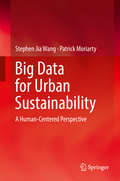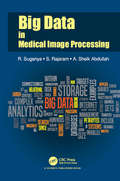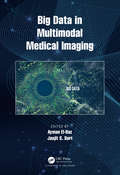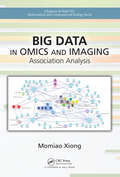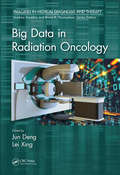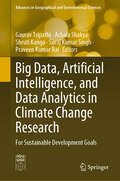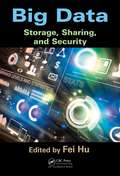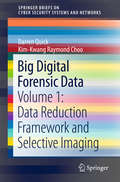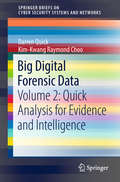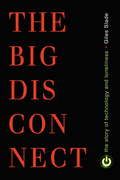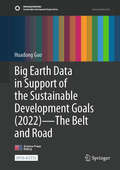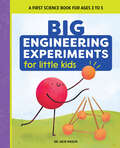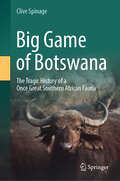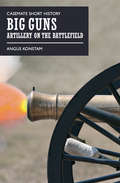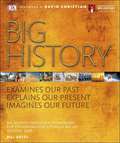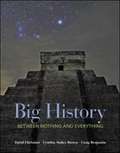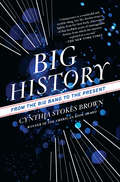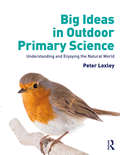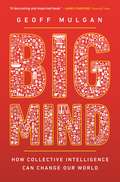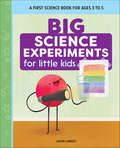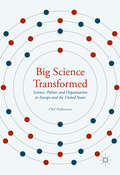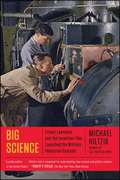- Table View
- List View
Big Data for Urban Sustainability
by Stephen Jia Wang Patrick MoriartyThis book presents a practical framework for the application of big data, cloud, and pervasive and complex systems to sustainable solutions for urban environmental challenges. It covers the technologies, potential, and possible and impact of big data on energy efficiency and the urban environment.The book first introduces key aspects of big data, cloud services, pervasive computing, and mobile technologies from a pragmatic design perspective, including sample open source firmware. Cloud services, mobile and embedded platforms, interfaces, operating system design methods, networking, and middleware are all considered. The authors then explore in detail the framework, design principles, architecture and key components of developing energy systems to support sustainable urban environments. The included case study provides a pathway to improve the eco-efficiency of urban transport, demonstrating how to design an energy efficient next generation urban navigation system by leveraging vast cloud data sets on user-behavior. Ultimately, this resource maps big data’s pivotal intersection with rapid global urbanization along the path to a sustainable future.
Big Data in Context: Legal, Social and Technological Insights (SpringerBriefs in Law)
by Thomas Hoeren Barbara Kolany-RaiserThis book is open access under a CC BY 4. 0 license. This book sheds new light on a selection of big data scenarios from an interdisciplinary perspective. It features legal, sociological and economic approaches to fundamental big data topics such as privacy, data quality and the ECJ's Safe Harbor decision on the one hand, and practical applications such as smart cars, wearables and web tracking on the other. Addressing the interests of researchers and practitioners alike, it provides a comprehensive overview of and introduction to the emerging challenges regarding big data. All contributions are based on papers submitted in connection with ABIDA (Assessing Big Data), an interdisciplinary research project exploring the societal aspects of big data and funded by the German Federal Ministry of Education and Research. This volume was produced as a part of the ABIDA project (Assessing Big Data, 01IS15016A-F). ABIDA is a four-year collaborative project funded by the Federal Ministry of Education and Research. However the views and opinions expressed in this book reflect only the authors' point of view and not necessarily those of all members of the ABIDA project or the Federal Ministry of Education and Research.
Big Data in Medical Image Processing
by S. Rajaram R. Suganya A. Sheik AbdullahThe field of medical imaging seen rapid development over the last two decades and has consequently revolutionized the way in which modern medicine is practiced. Diseases and their symptoms are constantly changing therefore continuous updating is necessary for the data to be relevant. Diseases fall into different categories, even a small difference in symptoms may result in categorising it in a different group altogether. Thus analysing data accurately is of critical importance. This book concentrates on diagnosing diseases like cancer or tumor from different modalities of images. This book is divided into the following domains: Importance of big data in medical imaging, pre-processing, image registration, feature extraction, classification and retrieval. It is further supplemented by the medical analyst for a continuous treatment process. The book provides an automated system that could retrieve images based on user’s interest to a point of providing decision support. It will help medical analysts to take informed decisions before planning treatment and surgery. It will also be useful to researchers who are working in problems involved in medical imaging.
Big Data in Multimodal Medical Imaging
by Jasjit S. Suri Ayman El-BazThere is an urgent need to develop and integrate new statistical, mathematical, visualization, and computational models with the ability to analyze Big Data in order to retrieve useful information to aid clinicians in accurately diagnosing and treating patients. The main focus of this book is to review and summarize state-of-the-art big data and deep learning approaches to analyze and integrate multiple data types for the creation of a decision matrix to aid clinicians in the early diagnosis and identification of high risk patients for human diseases and disorders. Leading researchers will contribute original research book chapters analyzing efforts to solve these important problems.
Big Data in Omics and Imaging: Association Analysis (Chapman & Hall/CRC Mathematical and Computational Biology)
by Momiao XiongBig Data in Omics and Imaging: Association Analysis addresses the recent development of association analysis and machine learning for both population and family genomic data in sequencing era. It is unique in that it presents both hypothesis testing and a data mining approach to holistically dissecting the genetic structure of complex traits and to designing efficient strategies for precision medicine. The general frameworks for association analysis and machine learning, developed in the text, can be applied to genomic, epigenomic and imaging data. FEATURES Bridges the gap between the traditional statistical methods and computational tools for small genetic and epigenetic data analysis and the modern advanced statistical methods for big data Provides tools for high dimensional data reduction Discusses searching algorithms for model and variable selection including randomization algorithms, Proximal methods and matrix subset selection Provides real-world examples and case studies Will have an accompanying website with R code The book is designed for graduate students and researchers in genomics, bioinformatics, and data science. It represents the paradigm shift of genetic studies of complex diseases– from shallow to deep genomic analysis, from low-dimensional to high dimensional, multivariate to functional data analysis with next-generation sequencing (NGS) data, and from homogeneous populations to heterogeneous population and pedigree data analysis. Topics covered are: advanced matrix theory, convex optimization algorithms, generalized low rank models, functional data analysis techniques, deep learning principle and machine learning methods for modern association, interaction, pathway and network analysis of rare and common variants, biomarker identification, disease risk and drug response prediction.
Big Data in Radiation Oncology (Imaging in Medical Diagnosis and Therapy)
by Jun Deng and Lei XingBig Data in Radiation Oncology gives readers an in-depth look into how big data is having an impact on the clinical care of cancer patients. While basic principles and key analytical and processing techniques are introduced in the early chapters, the rest of the book turns to clinical applications, in particular for cancer registries, informatics, radiomics, radiogenomics, patient safety and quality of care, patient-reported outcomes, comparative effectiveness, treatment planning, and clinical decision-making. More features of the book are: Offers the first focused treatment of the role of big data in the clinic and its impact on radiation therapy. Covers applications in cancer registry, radiomics, patient safety, quality of care, treatment planning, decision making, and other key areas. Discusses the fundamental principles and techniques for processing and analysis of big data. Address the use of big data in cancer prevention, detection, prognosis, and management. Provides practical guidance on implementation for clinicians and other stakeholders. Dr. Jun Deng is a professor at the Department of Therapeutic Radiology of Yale University School of Medicine and an ABR board certified medical physicist at Yale-New Haven Hospital. He has received numerous honors and awards such as Fellow of Institute of Physics in 2004, AAPM Medical Physics Travel Grant in 2008, ASTRO IGRT Symposium Travel Grant in 2009, AAPM-IPEM Medical Physics Travel Grant in 2011, and Fellow of AAPM in 2013. Lei Xing, Ph.D., is the Jacob Haimson Professor of Medical Physics and Director of Medical Physics Division of Radiation Oncology Department at Stanford University. His research has been focused on inverse treatment planning, tomographic image reconstruction, CT, optical and PET imaging instrumentations, image guided interventions, nanomedicine, and applications of molecular imaging in radiation oncology. Dr. Xing is on the editorial boards of a number of journals in radiation physics and medical imaging, and is recipient of numerous awards, including the American Cancer Society Research Scholar Award, The Whitaker Foundation Grant Award, and a Max Planck Institute Fellowship.
Big Data, Artificial Intelligence, and Data Analytics in Climate Change Research: For Sustainable Development Goals (Advances in Geographical and Environmental Sciences)
by Praveen Kumar Rai Shruti Kanga Suraj Kumar Singh Gaurav Tripathi Achala ShakyaThis book explores the potential of big data, artificial intelligence (AI), and data analytics to address climate change and achieve the Sustainable Development Goals (SDGs). Furthermore, the book covers a wide range of related topics, including climate change data sources, big data analytics techniques, remote sensing, renewable energy, open data, public–private partnerships, ethical and legal issues, and case studies of successful applications. The book also discusses the challenges and opportunities presented by these technologies and provides insights into future research directions.In order to address climate change and achieve the SDGs, it is crucial to understand the complex interplay between climate and environmental factors. The use of big data, AI, and data analytics can play a vital role in this effort by providing the means to collect, process, and analyze vast amounts of environmental data. This book is an essential resource for researchers, policymakers, and practitioners interested in leveraging these technologies to tackle the pressing challenge of climate change and achieve the SDGs.
Big Data: Storage, Sharing, and Security
by Fei HuAlthough there are already some books published on Big Data, most of them only cover basic concepts and society impacts and ignore the internal implementation details-making them unsuitable to R&D people. To fill such a need, Big Data: Storage, Sharing, and Security examines Big Data management from an R&D perspective. It covers the 3S desi
Big Digital Forensic Data: Volume 2: Quick Analysis For Evidence And Intelligence (SpringerBriefs On Cyber Security Systems And Networks)
by Kim-Kwang Raymond Choo Darren QuickThis book provides an in-depth understanding of big data challenges to digital forensic investigations, also known as big digital forensic data. It also develops the basis of using data mining in big forensic data analysis, including data reduction, knowledge management, intelligence, and data mining principles to achieve faster analysis in digital forensic investigations. By collecting and assembling a corpus of test data from a range of devices in the real world, it outlines a process of big data reduction, and evidence and intelligence extraction methods. Further, it includes the experimental results on vast volumes of real digital forensic data. The book is a valuable resource for digital forensic practitioners, researchers in big data, cyber threat hunting and intelligence, data mining and other related areas.
Big Digital Forensic Data: Volume 2: Quick Analysis for Evidence and Intelligence (SpringerBriefs on Cyber Security Systems and Networks)
by Kim-Kwang Raymond Choo Darren QuickThis book provides an in-depth understanding of big data challenges to digital forensic investigations, also known as big digital forensic data. It also develops the basis of using data mining in big forensic data analysis, including data reduction, knowledge management, intelligence, and data mining principles to achieve faster analysis in digital forensic investigations. By collecting and assembling a corpus of test data from a range of devices in the real world, it outlines a process of big digital forensic data analysis for evidence and intelligence. It includes the results of experiments on vast volumes of real digital forensic data. The book is a valuable resource for digital forensic practitioners, researchers in big data, cyber threat hunting and intelligence, data mining and other related areas.
Big Disconnect
by Giles SladeSmart phones and social media sites may be contemporary fixations, but using technology to replace face-to-face interactions is not a new cultural phenomenon. Throughout our history, intimacy with machines has often supplanted mutual human connection. This book reveals how consumer technologies changed from analgesic devices that soothed the loneliness of a newly urban generation to prosthetic interfaces that act as substitutes for companionship in modern America. The history of this transformation helps explain why we use technology to mediate our connections with other human beings instead of seeking out face-to-face contact. Do electronic interfaces receive most of our attention to the detriment of real interpersonal communication? Why do sixty million Americans report that isolation and loneliness are major sources of unhappiness? The author provides many insights into our increasingly artificial relationships and a vision for how we can rediscover genuine community and human empathy.
Big Earth Data in Support of the Sustainable Development Goals (Sustainable Development Goals Series)
by Huadong GuoThis open access book showcases the innovative practices of Big Earth Data methods through a collection of global comprehensive case studies to monitor and evaluate indicators for seven SDGs, i.e., zero hunger (SDG 2), clean water and sanitation (SDG 6), affordable and clean energy (SDG 7), sustainable cities and communities (SDG 11), climate action (SDG 13), life below water (SDG 14), life on land (SDG 15), and to analyzes the interactions among multiple SDGs indicators. The emphasis on Big Earth Data is highly relevant within the context of growing global challenges. Disaster risk mitigation, climate change, global food security, resource management, and environmental challenges all are interlinked through earth systems and processes that are independent of human constructs. Therefore these case studies highlight methods and practices of spatial information mining and integrated SDG evaluation, which include evaluating the synergy and trade-off relationships among the SDGs in the context of their correlations; simulating multiple indicators’ interactions in environmental, economic, and social scenarios in the context of their temporal variations; designing integrated evaluations of regional SDGs in the context of experience with the study of multiple indicators. Big Earth Data therefore has the potential to support informed policy and decision support at global, regional, and local scales.
Big Earth Data in Support of the Sustainable Development Goals (Sustainable Development Goals Series)
by Huadong GuoThis open access book showcases the innovative practices of Big Earth Data methods through a collection of comprehensive case studies from China to monitor and evaluate indicators for seven SDGs, i.e., zero hunger (SDG 2), clean water and sanitation (SDG 6), affordable and clean energy (SDG 7), sustainable cities and communities (SDG 11), climate action (SDG 13), life below water (SDG 14), life on land (SDG 15), and to analyze the interactions among multiple SDGs indicators. The emphasis on Big Earth Data is highly relevant within the context of growing global challenges. Disaster risk mitigation, climate change, global food security, resource management, and environmental challenges all are interlinked through earth systems and processes that are independent of human constructs. Therefore, these case studies highlight methods and practices of spatial information mining and integrated SDG evaluation, which include evaluating the synergy and trade-off relationships among the SDGs in the context of their correlations; simulating multiple indicators’ interactions in future environmental, economic and social scenarios in the context of their temporal variations; designing integrated evaluations of regional SDGs in the context of experience with the study of multiple indicators. Big Earth Data therefore has the potential to support informed policy and decision support at global, regional, and local scales.
Big Engineering Experiments for Little Kids: A First Science Book for Ages 3 to 5 (Big Experiments for Little Kids)
by Dr. Jacie MaslykExciting engineering experiments for kids ages 3 to 5 Kids are curious about how stuff works! They like to ask questions, come up with ideas, and try things out for themselves. Big Engineering Experiments for Little Kids helps activate their imaginations and shows them real engineering in action. When STEAM learning starts early, kids can prepare for scholastic success and a lifelong habit of creative and analytical thinking. Dive into engineering for kids with: 20 kid-friendly experiments—With some basic household items, kids can build a spaghetti bridge, construct a flying paper airplane, and feel how sound travels through their body! Easy instructions—These experiments are simple enough for kids to do with just a little help from a grownup, so they can practice independent learning. Engineering exploration—Each experiment shows off a different facet of engineering for kids, with explanations and thoughtful questions that illustrate how it works. Encourage little ones to explore the workings of the world with a fun book of activities that explore engineering for kids.
Big Game of Botswana: The Tragic History of a Once Great Southern African Fauna
by Clive SpinageQuoting contemporary accounts from hunters, missionaries and traders from the early nineteenth century onwards, this book illustrates the ecology of the country as it was emphasizing its rich large mammal fauna, its decline from increasing aridity of the country, it destruction by hunters, by disease, and most importantly, destruction of its vast herds, notably of wildebeest, due to the developing beef export economy and the erection of veterinary cordon fences depriving the large game of migration routes in times of drought. Once possessing one of the greatest animal displacements in Africa, with huge migrations of antelope, this book underlines the reality that the fauna of Botswana today is but a tiny remnant of what was perhaps once one of the the greatest spectacles of big game on earth. It shows how the decline came about -- and the controls exercised by tribal chiefs illustrating the indigenous peoples’ attitudes, and eventual protective measures both tribal and statutory. Whereas the pessimistic predictions of extinction at the end of the nineteenth century have happily not come true, nonetheless, the continued existence of this once great fauna is increasingly threatened by climate change threatening an already fragile balance, and human population increase with its increasing economic demands and changes in land use. The study fills a gap in the literature of African wildlife conservation and is distinctive by drawing upon a rich historical background.
Big Gin: The Rebirth of One of the World’s Oldest Spirits
by Emanuele MensahEverything the connoisseur could ever want to know about gin, the spirit that sparked a worldwide distilling boom.Nothing communicates elegance and refinement like a Martini. Nothing refreshes on a warm summer day like a Gin & Tonic. It is no accident that gin stands at the center of these iconic cocktails, as its bold, unique character leaves a lasting impression everywhere it appears. Big Gin is the definitive exploration into this beloved spirit, tracing its history from London&’s Gin Craze to the recent renaissance that sparked a worldwide distilling boom.Aficionados will find their appreciation for their favorite varieties deepened and discover new varieties to fall in love with, while the cocktail connoisseur will uncover innovative craft offerings that are pushing the spirit in exciting directions.Inside you&’ll find:The history of ginA breakdown of the botanicals that lend gin its unique characterAn in-depth exploration of the predominant style, London dryProfiles of Hendrick&’s, Tanqueray, Beefeater, and other major playersInterviews with the master distillers who are both preserving tradition and pushing the spirit forwardRecipes for the perfect Martini, Gin & Tonic, Negroni, and other beloved gin-based cocktails
Big Guns: Artillery on the Battlefield (Casemate Short History)
by Angus KonstamA concise, illustrated introduction to artillery from medieval times to the modern era. Over seven centuries, the artillery piece has evolved from a status symbol to one of the most deadly weapons wielded by man. Using gunpowder weapons was initially something of a black art, but over time, gunnery became a science, a dependable method of breaching fortifications or overcoming an enemy on the battlefield. By the nineteenth century, most European armies had artillery units manned with trained gunners; Napoleon, originally an artillery officer, then took the use of artillery to a new level. Over the following decades, rapid advances in gun technology paved the way for the devastatingly powerful heavy artillery that literally transformed the landscape during World War I. The use of rolling and box barrages shaped how armies fought on the front lines, and powerful naval guns dictated the outcome of battles at sea. By World War II, the range of artillery had expanded to include self-propelled guns and powerful antitank and antiaircraft guns. In this informative introduction, historian Angus Konstam concisely explains how the development and evolving deployment of artillery led to big guns becoming the key to victory in two world wars and a potent force on the modern battlefield.
Big History Examines Our Past Explains Our Present Imagines Our Future
by David ChristianFeaturing a foreword by the father of Big History, David Christian, and produced in association with the Big History Institute, Big History provides a comprehensive understanding of the major events that have changed the nature and course of life on the planet we call home. This first fully integrated visual reference on Big History for general readers places humans in the context of our universe, from the Big Bang to virtual reality. Why does the universe work the way it does? Why are stars so big? Why are humans so small? What does it mean to be human? Big History blends geology, biology, physics, anthropology, sociology, and so much more to tell one coherent story, taking us right back to our origins and exploring how a unique series of events led to and then impacted human existence: how everything came to be, where we fit in, and even where we are going. Graphics, artworks, timelines, and at-a-glance overviews make the causes and effects of pivotal events and major thresholds in Big History instantly accessible, and evidence features explain how we know what we know. An additional 64-page reference section provides a more conventional account of events in human history. Placing humans in the context of our universe and revealing how and why we got to where we are today, Big History covers 13.8 billion years of history, from the formation of the universe and the dawn of time to the present day.
Big History: Between Nothing and Everything
by David Christian Craig Benjamin Cynthia BrownBig History: Between Nothing and Everything surveys the past not just of humanity, or even of planet Earth, but of the entire universe. In reading this book instructors and students will retrace a voyage that began 13.7 billion years ago with the Big Bang and the appearance of the universe. Big history incorporates findings from cosmology, earth and life sciences, and human history, and assembles them into a single, universal historical narrative of our universe and of our place within it. <P><P> The first edition of Big History: Between Nothing and Everything, is written by the pioneers of the field, and presents a framework for learning about anything and everything. It encourages students to think critically about our cumulative history and the future of the world through a variety of lenses.
Big History: From the Big Bang to the Present
by Cynthia Stokes Brown&“This exciting saga crosses space and time to illustrate how humans, born of stardust, were shaped—and how they in turn shaped the world we know today.&” —Publishers Weekly This book offers &“world history on a grand scale&”—pulling back for a wider view and putting the relatively brief time span of human history in context. After all, our five thousand years of recorded civilization account for only about one millionth of the lifetime of our planet (Kirkus Reviews). Big History interweaves different disciplines of knowledge, drawing on both the natural sciences and the human sciences, to offer an all-encompassing account of history on Earth. This new edition is more relevant than ever before, as we increasingly grapple with accelerating rates of change and, ultimately, the legacy we will bequeath to future generations. Here is a path-breaking portrait of our world, from the birth of the universe from a single point the size of an atom to life on a twenty-first-century planet inhabited by seven billion people.
Big Ideas in Outdoor Primary Science: Understanding and Enjoying the Natural World
by Peter LoxleyBig Ideas in Outdoor Primary Science takes a fresh approach to learning science in outdoor contexts. It combines new thinking in science teaching using big ideas, with our growing need to look after our planet, and encourages children to learn from what scientists have to say about issues which will impact their lives today and in the future. The book offers primary teachers the subject and pedagogical knowledge, as well as the confidence they need, to integrate the seeds of big ideas into their curriculum. To this end, it provides models of good practice which exemplify how primary-aged children can work towards understanding some of science’s big ideas and engage with important issues related to wildlife conservation. The easy-to-use book covers topics such as: Interdependence Adaptation Inheritance Following in Darwin’s footsteps Protecting ecosystems Full of ideas for outside learning, this book is a comprehensive, valuable and essential resource for all teachers of primary science.
Big Mind: How Collective Intelligence Can Change Our World
by Geoff MulganA new field of collective intelligence has emerged in the last few years, prompted by a wave of digital technologies that make it possible for organizations and societies to think at large scale. This “bigger mind”—human and machine capabilities working together—has the potential to solve the great challenges of our time. So why do smart technologies not automatically lead to smart results? Gathering insights from diverse fields, including philosophy, computer science, and biology, Big Mind reveals how collective intelligence can guide corporations, governments, universities, and societies to make the most of human brains and digital technologies.Geoff Mulgan explores how collective intelligence has to be consciously organized and orchestrated in order to harness its powers. He looks at recent experiments mobilizing millions of people to solve problems, and at groundbreaking technology like Google Maps and Dove satellites. He also considers why organizations full of smart people and machines can make foolish mistakes—from investment banks losing billions to intelligence agencies misjudging geopolitical events—and shows how to avoid them.Highlighting differences between environments that stimulate intelligence and those that blunt it, Mulgan shows how human and machine intelligence could solve challenges in business, climate change, democracy, and public health. But for that to happen we’ll need radically new professions, institutions, and ways of thinking.Informed by the latest work on data, web platforms, and artificial intelligence, Big Mind shows how collective intelligence could help us survive and thrive.
Big Science Experiments for Little Kids: A First Science Book for Ages 3 to 5
by Jason LindseyEntertainment meets education with thrilling science experiments for kids ages 3 to 5 Young children are naturally curious and love to discover new things about the world around them. Big Science Experiments for Little Kids helps them explore their inquisitive side with fun, hands-on experiments that introduce them to STEAM concepts (science, technology, engineering, art, and math). This standout among science books for kids 3-5 features:20 engaging experiments—Learning is a blast as kids explore basic scientific principles using everyday objects, like combining raisins and soda to see the effects of carbon dioxide in Dancing Raisins.Avenues for investigation—Children will develop problem-solving skills as they learn to ask questions, gather information, make guesses, and explain their discoveries.Simple directions—Kids can experiment with ease thanks to clear, step-by-step instructions that foster independent learning and require minimal supervision from adults.Explicit icons—You'll know how to properly plan thanks to labels that alert you to a possible mess, when you may need to step in, and how long it should take to successfully complete the experiment.Make learning come alive with Big Science Experiments for Little Kids.
Big Science Transformed: Science, Politics and Organization in Europe and the United States
by Olof HallonstenThis book analyses the emergence of a transformed Big Science in Europe and the United States, using both historical and sociological perspectives. It shows how technology-intensive natural sciences grew to a prominent position in Western societies during the post-World War II era, and how their development cohered with both technological and social developments. At the helm of post-war science are large-scale projects, primarily in physics, which receive substantial funds from the public purse. Big Science Transformed shows how these projects, popularly called 'Big Science', have become symbols of progress. It analyses changes to the political and sociological frameworks surrounding publicly-funding science, and their impact on a number of new accelerator and reactor-based facilities that have come to prominence in materials science and the life sciences. Interdisciplinary in scope, this book will be of great interest to historians, sociologists and philosophers of science.
Big Science: Ernest Lawrence and the Invention that Launched the Military-Industrial Complex
by Michael HiltzikThe epic story of how science went “big” and the forgotten genius who started it all—“entertaining, thoroughly researched…partly a biography, partly an account of the influence of Ernest Lawrence’s great idea, partly a short history of nuclear physics and the Bomb” (The Wall Street Journal).Since the 1930s, the scale of scientific endeavor has grown exponentially. The first particle accelerator could be held in its creator’s lap, while its successor grew to seventeen miles in circumference and cost ten billion dollars. We have invented the atomic bomb, put man on the moon, and probed the inner workings of nature at the scale of subatomic particles—all the result of Big Science, the model of industrial-scale research paid for by governments, departments of defense, and corporations that has driven the great scientific projects of our time. The birth of Big Science can be traced nearly nine decades ago in Berkeley, California, when a young scientist with a talent for physics declared, “I’m going to be famous!” His name was Ernest Orlando Lawrence. His invention, the cyclotron, would revolutionize nuclear physics, but that was only the beginning of its impact, which would be felt in academia, industry, and international politics. It was the beginning of Big Science. “An exciting book….A bright narrative that captures the wonder of nuclear physics without flying off into a physics Neverland….Big Science is an excellent summary of how physics became nuclear and changed the world” (The Plain Dealer, Cleveland). This is the “absorbing and expansive” (Los Angeles Times) story that is “important for understanding how science and politics entwine in the United States…with striking details and revealing quotations” (The New York Times Book Review).
